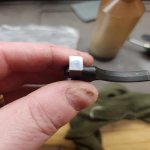For bench or prone shooting, having a forward weight distribution is fine, but people have complained the Templar is heavy in general and front heavy for more active use; just trying to suggest an alternative arrangement. If people are happy with the rifle the way it is, all power to them, and they're more then welcome to get it as is.
I think discussion of ways that a rifle can be theoretically (or practically) improved should always be welcome. I get Bartok's comment about making a rifle into something that it isn't is valid as well - a lot of people (not necessarily Ustauk) seem to want to always to want a rifle that deviates from the AR15 pattern to be changed back in that direction.
The Templar is definitely heavy in general (the Gen 2 less so) - the list above of weights that I linked established that the Gen 2 is on the heavier side of the spectrum of 5.56mm-firing semi-automatics. I keep on hearing people say "front heavy" about the Templar and to me that means the distribution of the weight is far enough forward it makes the rifle difficult to use, or at least less easily manipulated.
This is a genuine question and not trying to be argumentative - where is the point of balance on a firearm ideal for you, Ustauk? I'll also ask that question of the thread readers at large. I ask as a relatively new shooter trying to learn more about what more experienced shooters prefer or recommend.
When I Google the question, the typical answer is a) the midlength of the firearm, b) about 4.5-5.5" (some say as much as 6.5") in front of the trigger or c) either at the front of the magwell, the hinge pin, the midline of the magwell or the "tip of the bullet" in the magazine.
When you look at these metrics for the naked Templar, the balance point is a) roughly 19" from the barrel tip on the rifle when the stock is extended to what I (at a fairly common height of 5'11"/183cm) feel is a comfortable length, the rifle is 39" long, so 0.5" forward from exactly the mid-point of the rifle, b) about 4.5"-4.75" from the centre of the trigger guard c) about 1/4"-1/2" forward of the magwell with no optics or other accessories added, and somewhere between the front of the magwell and the middle of the magwell with common accessories (scope, foregrip) added.
Because by all the common metrics, the balance point is +/1 an 1" or less of where most people seem to think it should be, and 0.5" or less "off" from most of the given recommendations. I guess what I'm wondering is, when people pick up a Templar and say that it's front heavy, are they comparing it to an AR15? In other words, is it a matter of what people are
used to, rather than
what should be?
Another common theme that I read when I read threads about point of balance is that for "field use" - quick "snap" shots, etc. - further back makes the gun feel "livelier" - and further forward can, for some people, improve some aspects of precision shooting. Often repeated is that it's shooter's preference that should be the controlling factor - what feels best for the shooter when shooting in that person's most common firing position.
I am shooting roughly 50% of my 1400 rounds through the Templar upper so far from a supported position, but the other ~50% are from a standing, unsupported position, and about 80% of those shots (~40% of total fired) are quick snap shots at small targets. Is it as "lively" as a AR15? Maybe not, but I'm getting hits on target easily and consistently and it doesn't feel like I have to throw around the firearm to do so.
In a week or so I'll have a Bren 2 7.62x39mm 11" barrel firearm in my hands and I'll do some unsupported snap shooting with that firearm for comparison with a completely modern, slick, top-of-their-field designer-designed firearm, and we'll see how I feel about the difference. The recoil impulse and length is different, of course, but it'll give me another point of reference to add to my experiences with Bren 5.56mm 8" barrels, X95s and pre-ban AR15s.








































































